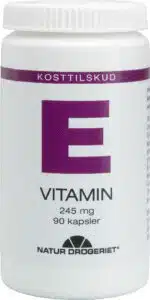E-vitamin er et essentielt næringsstof, der fungerer som antioxidant i menneskekroppen. Det er pr. definition essentielt, fordi kroppen ikke kan danne sit eget E-vitamin, og det skal derfor tilføres via kosten eller ved indtagelse af kosttilskud.
E-vitamin er en generel betegnelse, som omfatter alle de enheder, der udviser alfa-tocoferols biologiske aktivitet. I naturen har man fundet frem til otte stoffer, der har E-vitamin-aktivitet: Alfa-, beta-, gamma- og delta-tocoferol, samt alfa-, beta-, gamma- og delta-tocotrienol. De acetat- og succinat-afledte former af naturlige tocoferoler har E-vitamin-aktivitet, og det samme gælder syntetiske tocoferoler og deres acetat- og succinat-afledte former.
Er der forskel på naturligt og syntetisk E-vitamin?
Naturligt og syntetisk E-vitamin er ikke ensartet i opbygning, struktur og biologisk tilgængelighed. Naturligt E-vitamin (RRR-alfa-tocoferol eller d-alfa-tocoferol) er én enkelt enhed. Naturligt E-vitamin er på basis af dyreforsøg officielt anerkendt som værende 36 % stærkere end dets syntetiske modstykke. Men nyligt offentliggjorte kliniske forsøg med deuterium-mærket E-vitamin tyder på, at naturligt E-vitamins biologiske tilgængelighed er ca. dobbelt så høj som for syntetisk E-vitamin, fordi den naturlige form befinder sig i længere tid i kroppens væv.
Hvad er de potentielle fordele ved E-vitamin?
En tilstrækkelig tilførsel af E-vitamin beskytter kroppens celler og kan reducere risikoen for udvikling af de degenerative sygdomme, der kan opstå som resultat af iltningsbelastning og skader forårsaget af frie radikaler. Frie radikaler er normale biprodukter fra celleaktiviteten, og de har en nødvendig og endog ønskværdig funktion for kroppen. Men for mange frie radikaler som følge af en usund livsstil og mindre hensigtsmæssige kostvaner, sygdomme og miljøbelastninger kan beskadige cellerne og øge den pågældende persons risiko for sygdom.
E-vitamin er kroppens primære fedtopløselige antioxidant-forsvar mod skader forårsaget af frie radikaler. Forskningsresultater har sat celleskader på grund af frie radikaler i forbindelse med
sygdomme i hjertets kranspulsårer
- for tidlig aldring
- dannelse af grå stær
- leddegigt.
Andre forskningsresultater tyder på, at E-vitamin
- styrker immunforsvaret
- afhjælper natlig krampe i benene
- medvirker til at reducere PMS
- styrer blodpladernes evne til sammenklumpning – hvilket specielt er godt for personer med et højt indhold af fedtstoffer i blodet, diabetikere og kvinder, der spiser P-piller
- beskytter mod solstråler, luftforurening og miljøgifte.
Selv i høje doser har E-vitamin generelt ingen betydelige bivirkninger hos raske personer. Man er bekendt med bivirkning som diarré, træthed, udmattethed, kramper i tarmsystemet, brystspændinger, thrombophlebitis og akne.
Hovedparten af bivirkningerne er beskrevet i breve fra individuelle patienter eller fra ukontrollerede forsøg. De færreste er blevet påvist ved større, velkontrollerede forsøg. På basis af en gennemgang af de forhåndenværende forsøgsresultater kan man konkludere, at E-vitamin er sikkert og kan tåles af stort set alle over længere perioder og i mange forskellige doser.
Læs også
Naturligt E-vitamin – naturligvis!
E-vitamin og leddegigt
Sådan kan E-vitamin forebygge hjerteanfald
E-vitamin og blodplader
E-vitamin er godt for din kognitive funktion
E-vitamin og grå stær
E-vitamin og immunforsvar
Carotenoider og E-vitamin – din indvendige solbeskyttelse
E-vitamin forlænger livet for Alzheimer-patienter
E-vitamin under graviditeten mindsker risikoen for astma hos børn
E-vitamin beskytter kroppen ved træning
Dette bør du vide om vitaminer og mineraler
Vælg det rigtige multivitamin-/mineralpræparat – Maximum!
Kilder
Weiser H, Vecchi M. Stereoisomers of alfa-Tocopheryl Acetat, II. Biopotencies of All Eight Stereoisomers, Individually or in Mixtures, as Determined by Rat Resorption-Gestation Tests. Int. J. Vit. Nutr. Res. 52:351-370, 1982.
Traber MG, Elsner A, Brigelius-Flohe R. Synthetic as Compared With Natural Vitamin E Is Preferentially Excreted as Alpha-CEHC in Human Urine: Studies Using Deuterated Alpha-Tocopheryl Acetates. FEBS Letters 437:145-148, 1998.
Acuff RV, Thedford SS, Hidiroglou NN, Papas AM, Odom TA. Relative Bioavailability of RRR- and All-Rac-Alpha-Tocopheryl Acetate in Humans: Studies Using Deuterated Compounds. Am. J. Clin. Nutr. 60:397-402, 1994.
Kiyose C, Muramatsu R, Kameyama Y, Ueda T, Igarashi O. Biodiscrimination of Alpha-Tocopherol Stereoisomers in Humans after Oral Administration. Am. J. Clin. Nutr. 65:785-789, 1997.
Acuff RV, Dunworth RG, Webb LW, Lane JR. Transport of Deuterium-Labeled Tocopherols during Pregnancy. Am. J. Clin. Nutr. 67:459-464, 1998.
Burton GW et al. Humane Plasma and Tissue Alpha-Tocopherol Concentrations in Response to Supplementation with Deuterated Natural and Synthetic Vitamin E. Am. J. Clin. Nutr. 67:669-684, 1998.
Kitabchi AE, Wimalasena J, Barker J. Specific Receptor Sites for Alpha-Tocopherol in Purified Isolated Adrenocortical Cell Membrane. Biochem. Biophys. Res. Comm. 96:1739-1746, 1980.
Hosomi A et al. Affinity for Alpha-Tocopherol Transfer Protein as a Determinant of the Biological Activities of Vitamin E Analogs. FEBS Letters 409:105-108, 1997.
Cross CE. Oxygen Radicals and Human Disease. Ann. Intern. Med. 107:526-545, 1987.
Bauernfeind JB. Tocopherols in Foods. I: Vitamin E: A Comprehensive Treatise. Marcel Dekker, Inc., New York og Basel, pp. 99-167, 1980.
Lemoyne M, Van Gossum A, Kurian R, Ostro M, Jeejeebhoy KN. Breath Pentane Analyses as an Index of Lipid Peroxidation: A Functional Test of Vitamin E Status. Am. J. Clin. Nutr. 46:267-272, 1987.
Van Gossum A, Kurian R, Whitwell J, Jeejeebhoy KN. Decrease in Lipid Peroxidation Measured by Breath Pentane Output in Normals after Oral Supplementation with Vitamin E. Clin. Nutr., 7:53-57, 1988.
Gey KF, Puska P. Plasma Vitamins E and A Inversely Correlated to Mortality from Ischemic Heart Disease in Cross-Cultural Epidemiology. Ann. N. Y. Acad. Sci. 570:268-282, 1989.
Singh RB et al. Dietary Intake, Plasma Levels of Antioxidant Vitamins and Oxidative Stress in Relation to Coronary Artery Disease in Elderly Subjects. Am. J. Cardiol. 76:1233-1238, 1995.
Salonen JT et al. Serum Fatty Acids, Apolipoproteins, Selenium and Vitamin Antioxidants and the Risk of Death from Coronary Artery Disease. Am. J. Cardiol. 56:226-231, 1985.
Kok FJ et al. Serum Selenium, Vitamin Antioxidants and Cardiovascular Mortality: A 9-Year Follow-Up Study in the Netherlands. Am. J. Clin. Nutr. 45:462-468, 1987.
Torun M, Avci N, Yardim S. Serum Levels of Vitamin E in Relation to Cardiovascular Diseases. J. Clin. Pharm. Ther. 20:335-340, 1995.
Sklodowska M et al. Selenium and Vitamin E Concentrations in Plasma and Erythrocytes of Angina Pectoris Patients. Trace Elem. Med. 8:113-117, 1991.
Kostner K et al. Is Oxidative Stress Causally Linked to Unstable Angina Pectoris? A Study in 100 CAD Patients and Matched Controls. Cardiovasc. Res. 36:330-336, 1997.
Riemersma RA, Wood DA, Macintyre CCA, Elton RA, Gey KF, Oliver MF. Risk of Angina Pectoris and Plasma Concentrations of Vitamins A, C and E and Carotene. Lancet 337:1-5, 1991.
Regnstrom J et al. Inverse Relation Between the Concentration of Low-Density Lipoprotein Vitamin E and Severity of Coronary Artery Disease. Am. J. Clin. Nutr. 63:377-385, 1996.
Street DA et al. Serum Antioxidants and Myocardial Infarction – Are Low Levels of Carotenoids and Alpha-Tocopherol Risk Factors for Myocardial Infarction? Circulation 90:1154-1161, 1994.
Knekt P, Reunanen A, Jarvinen R, Seppanen R, Heliovaara M, Aromaa A. Antioxidant Vitamin Intake and Coronary Mortality in a Longitudinal Population Study. Am. J. Epidemiol. 139:1180-1189, 1994.
Bellizzi MC, Franklin MF, Duthie GG, James WPT. Vitamin E and Coronary Heart Disease: The European Paradox. Eur. J. Clin Nutr. 48:822-831, 1994.
Kushi LH et al. Dietary Antioxidant Vitamins and Death from Coronary Heart Disease in Postmenopausal Women. New Engl. J. Med. 334:1156-1162, 1996.
Losonczy KG, Harris TB, Havlik RJ. Vitamin E and Vitamin C Supplement Use and Risk of All-Cause and Coronary Heart Disease Mortality in Older Persons: The Established Populations for Epidemiologic Studies of the Elderly. Am. J. Clin. Nutr. 64:190-196, 1996.
Meyer F, Bairati I, Dagenais GR. Lower Ischemic Heart Disease Incidence and Mortality Among Vitamin Supplement Users. Can. J. Cardiol. 12:930-934, 1996.
Hodis HN et al. Serial Coronary Angiographic Evidence that Antioxidant Vitamin Intake Reduces Progression of Coronary Artery Atherosclerosis. J.A.M.A. 273:1849-1854, 1995.
Rimm EB et al. Vitamin E Consumption and the Risk of Coronary Heart Disease in Men. New Engl. J. Med. 328:1450-1456, 1993.
Stampfer MJ et al. Vitamin E Consumption and the Risk of Coronary Disease in Women. New Engl. J. Med. 328:1444-1449, 1993.
Stephens NG et al. Randomised Controlled Trial of Vitamin E in Patients with Coronary Disease: Cambridge Heart Antioxidant Study (CHAOS). Lancet 347:781-786, 1996.
Zaman Z et al. Plasma Concentrations of Vitamins A and E and Carotenoids in Alzheimer’s Disease. Age and Ageing 21:91-94, 1992.
Morris MC et al. Vitamin E and Vitamin C Supplement Use and Risk of Incident Alzheimer Disease. Alzheimer Disease and Assoc. Disorders 12:121-126, 1998.
Sano M et al. A Controlled Clinical Trial of Selegiline, Alpha-Tocopherol or Both as Treatment for Alzheimer’s Disease. New Engl. J. Med. 336:1216-1222, 1997.
Jacques PF, Chylack LT, McGandy RB, Hartz SC. Antioxidant Status in Persons With and Without Senile Cataract. Arch. Ophthalmol. 106:337-340.
Knekt P et al. Serum Antioxidant Vitamins and Risk of Cataract. Brit. Med. J. 305:1392-1394, 1992.
Rouhiainen P, Rouhiainen H, Salonen JT. Association Between Low Plasma Vitamin E Concentration and Progression of Early Cortical Lens Opacities. Am. J. Epidemiol. 144:496-500, 1996.
Robertson JM, Donner AP, Trevithick JR. Vitamin E Intake and Risk of Cataracts in Humans. Ann. N. Y. Acad. Sci. 570:372-382, 1989.
Leske MC et al. Antioxidant Vitamins and Nuclear Opacities. Ophthalmology 105:831-836, 1998.
Lyle BJ et al. Serum Carotenoids and Tocopherols and Incidence of Age-Related Nuclear Cataract. Am. J. Clin. Nutr. 69:272-277, 1999.
Bendich A, Machlin LJ. Safety of Oral Intake of Vitamin E. Am. J. Clin. Nutr. 48:612-619, 1988.
Kappus H, Diplock AT. Tolerance and Safety of Vitamin E: A Toxicological Position Report. Free Rad. Biol. Med. 13:55-74, 1992.
Burton GW et al. Comparison of Free Alpha-Tocopherol and Alpha-Tocopheryl Acetate as Sources of Vitamin E in Rats and Humans. Lipids 23:834-840, 1988.
Cheeseman KH et al. Biokinetics in Humans of RRR-Alpha-Tocopherol: The Free Phenol Acetate Ester and Succinate Ester Forms of Vitamin E. Free Rad. Biol. Med. 19:591-598, 1995.


 sygdomme i hjertets kranspulsårer
sygdomme i hjertets kranspulsårer